Hibiscus is charming and mysterious. A gentle flower in our northern latitudes is accompanied by gloomy legends. However, at home, the eastern rose is a symbol of women's happiness, love and beauty. We learn to grow hibiscus, attract happiness to the house, we are looking for an explanation of signs and superstitions.
Contents
- Hibiscus - Chinese rose: species
- Hibiscus - flower of death: why? Signs and superstitions
- Growing hibiscus at home. Care
- temperature
- Soil Fertilizing Watering
- transplant
- Illumination
- Crop Moisture
- Video: Pruning hibiscus
- Growing hibiscus in the open field
- Illumination
- Watering
- Spraying Fertilizing Soil
- How to prepare a place for planting hibiscus?
- Pruning
- Hibiscus Terry: Home Care, Growing
- How to prepare the stalk?
- Cultivation and care of Syrian hibiscus. Growing and caring for treelike hibiscus
- Propagation of hibiscus at home
- Hibiscus transplanting
- Video: Spring transplant and trimming of hibiscus
- Why does the indoor flower hibiscus flower? What should I do?
- Why yellow and fall leaves and buds of hibiscus: flower diseases
- Video: Hibiscuses on the windowsill
Hibiscus - Chinese rose:
species Interesting. The word Hibiscus originated from the Greek word "hibiskos", which means mallow.
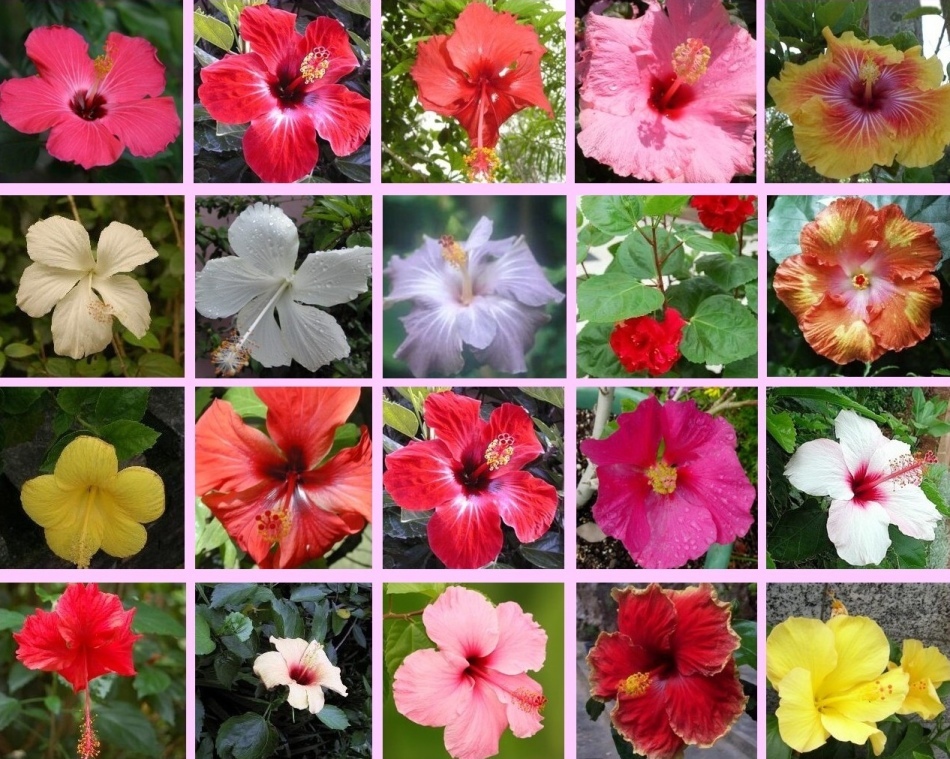 . Variety of species of hibiscus.
. Variety of species of hibiscus. . This is one of the few plants whose life forms include:
- herbaceous plants
- half-shrubs
- shrubs
- small trees
Botany knows about 300 species of hibiscus. The most popular of them are:
- triple / northern
- Syrian
- frost-resistant garden / grassy
- Chinese
- changeable / lotus tree
- marsh
Modern selection offers a variety of hybrid plant varieties that allows even inexperienced growers to enjoy abundant flowering of hibiscus in their garden or on the windowsill
Hibiscus is the flower of death: why? Signs and superstitions of
Many exalted persons tend to see a bad sign in the short bloom of each individual hibiscus flower. Recall, the flower of hibiscus lives from 1 to 3 days. At the same time, the flowering period of the plant takes about 6 months( from April to October), which corresponds to the natural rhythm of life of the majority of representatives of the tropical flora.
Important. Esotericists are advised to pay attention only to the "unplanned" flowering of hibiscus. Pay attention, not wait for death!
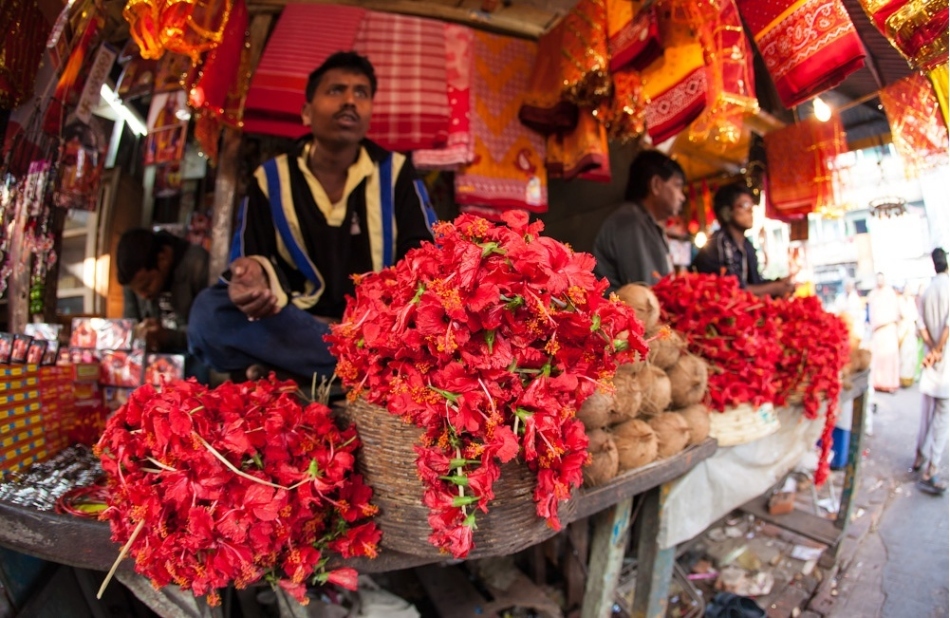 For the followers of Hinduism scarlet hibiscus flowers symbolize the feelings and soul of a person
For the followers of Hinduism scarlet hibiscus flowers symbolize the feelings and soul of a person Another explanation for gloomy superstitions can be found in the ancient Indian epic. One of the most violent goddesses in Hinduism - Kali - embodies destruction and death. It is Kali who is supposed to present hibiscus flowers while visiting the temple of the goddess. But how does Hinduism interpret death? Simplified is the beginning of something new. For the inhabitants of India, Kali is one of the most revered goddesses, and hibiscus is one of the most loved flowering plants.
. Chinese rose flowers are revered in South Korea and the islands of Polynesia. For example, the scarlet flower of hibiscus is a symbol of the paradise island of Haiti
. In general, the gloomy speculations accompanying the flowering of hibiscus are most likely associated with a "pop" acquaintance with the culture of Asia and Oceania and are completely groundless.
Growing hibiscus at home. Care
Important: when buying a plant, be sure to check that the lowest buds of the
have fallen from the flower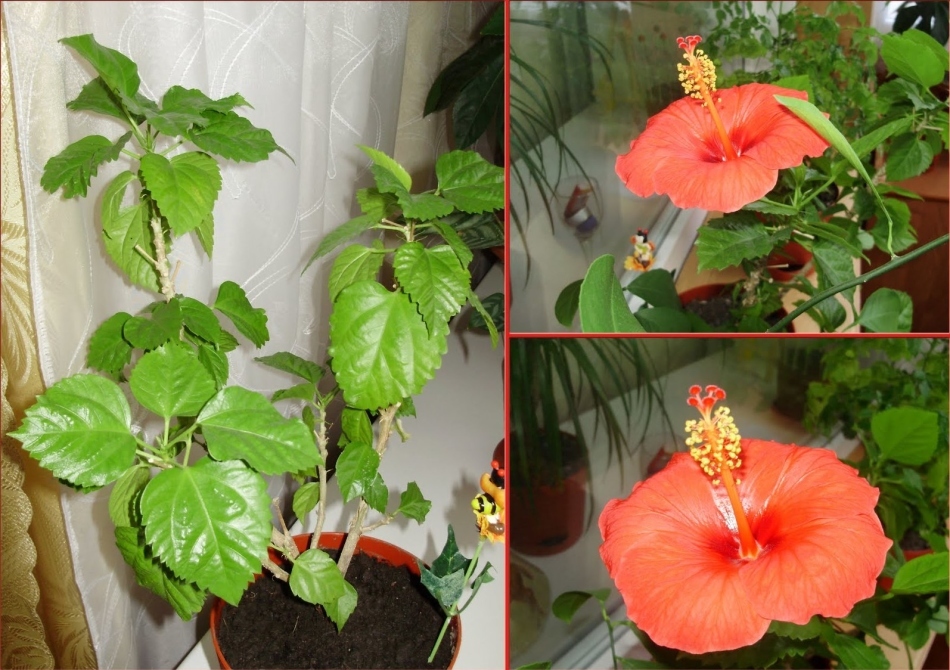 Greenhouse / Indoor Hibiscus or Chinese Rose
Greenhouse / Indoor Hibiscus or Chinese Rose Subject to the basic rules of maintenance and care, the plant will delight its owners with abundant and prolonged flowering. Hybrid varieties often bloom year-round, making only small breaks
Temperature
- spring / summer -18-21 ° C( maximum - 27 ° C)
- winter - at least 13 ° C
Soil
Equal parts of peat and clay substrate. For adult plants, the proportions are somewhat different: 2 parts of clay substrate and 1 part of peat
Watering
- At high air temperatures( in summer): 2-3 times a week. Humidity must be constant. Avoid waterlogging or drying out of the soil.
- In the winter: once a week. Be careful, the need for watering is indicated by the dried surface of the
- soil. At temperatures below 13 ° C: bi-weekly
- Fertilizing Spring / Summer: Once every 2 weeks, especially after the appearance of the buds. As a top dressing, liquid fertilizers are used for flowering tropical plants.
Important: for abundant flowering, enrich the soil with phosphorus salts. Be sure to take into account the manufacturer's recommendations regarding the dosage of the fertilizer. The excess of phosphorus for the plant is very harmful and can lead to the death of the flower. In the period of vegetative activity, hibiscus loves mineral fertilizers with a high content of potassium, copper and iron;in a moderate amount - nitrogen
- during the rest period the plant does not need additional feeding
Transplant
Every spring, before the beginning of the period of active growth. Transplant should be in the flower pot, which is larger than the previous one by one size.
Illumination of
Scattered light. Duration: 6-12 hours
Pruning
In the spring, before the beginning of the period of active growth. With a pruner or sharp scissors, shorten the stems of the plant. Crop at an angle above the leaf or just above the side shoot. Sprinkle the cut ends with cinnamon powder or powdered activated carbon
Air humidity
At high temperatures and relative air dryness( spring / summer) the plant needs daily spraying with warm soft water
Video: Hibiscus trim
Hibiscus cultivation in the open ground
 Garden hibiscus onsection
Garden hibiscus onsection The main agrotechnical characteristics of hibiscus grown in the open ground, look as follows
- Long-term unpretentious bush. In winter, the ground part dies off, new shoots appear in May
- Flowering starts in the second half of summer and lasts for several weeks
- With proper care, the flower size can reach 20-30 cm
- Garden hibiscuses require a lot of sunlight and moisture
- Well winter, but require little hidingfor the winter( for example, from above it is possible to pour a layer of earth 15-20 cm in height)
- Propagate by seeds, chunks, live animals
- Life period: up to 20 years
Illumination
Well-lit placee 6 hours of diffuse sunlight per day)
Watering
Garden varieties of hibiscus delight the eye with large leaves and flowers that require a lot of moisture.
Watering is conditionally divided into two periods
- spring / summer( high temperatures): stable water supply. During this period, it is important to prevent water stagnation in the root ball, in order to avoid rotting of the
- roots, winter( low temperatures, high humidity): a rare watering, only after the upper layer of soil is well dried around the ground part of the plant.
Spraying
Likes spraying even in open ground conditions. Garden hibiscus( especially marsh) will enjoy the presence of a pond nearby. If there is no such on the site, then simply put a container of water near the plant
. Feeding
- spring / summer: 1 time in 2 weeks, especially after the appearance of flower buds. As a top dressing liquid fertilizers are used for flowering tropical plants. The organic fertilizers
are also popular with experienced gardeners. Important: for abundant flowering, enrich the soil with phosphorus salts. Be sure to take into account the manufacturer's recommendations regarding the dosage of the fertilizer. The excess of phosphorus for the plant is very harmful and can lead to the death of the flower. In the period of vegetative activity, hibiscus loves mineral fertilizers with a high content of potassium( especially on the eve of the rest period), copper and iron;in a moderate amount - nitrogen
- during the rest period the plant does not need additional feeding
Soil
Hibiscuses very much like acidified soil( in this they are very close with roses).The place for planting is prepared in the autumn period.
. How to prepare a place for planting hibiscuses?
1. Prepare a mixture of dressings for the soil.
- superphosphate granular - 40 g
- granulated gravel - 40 g
- river sand - 5 l
- bovine humus - 5 l
- yellow clay( carefully dried and crushed) - 5 liters
- peat turf - 5 l
2. Pour the mixture evenlyfor the site previously cleaned from weeds
3. Fold the digs
Trimming
The procedure is performed only for an adult plant( age is more than 4 years)
Important: the length of the trimmed part should be 20-25% of the length of the branch / shoot
zhnyh scrap
- spring
to stimulate flowering
- sanitary( puncturing)
deleted damaged, diseased, shrunken branches / shoots. Healthy tissue is green
- corrective
For
- bush molding
is performed after flowering, not later than September
- radical
All branches / shoots are cut off. It is extremely rare if the plant is threatened with death of
. Important: for young plants( up to 4 years old), no trimming procedure is performed! The upper branches of young hibiscus need only pinching.
Hibiscus terry: home care, growing
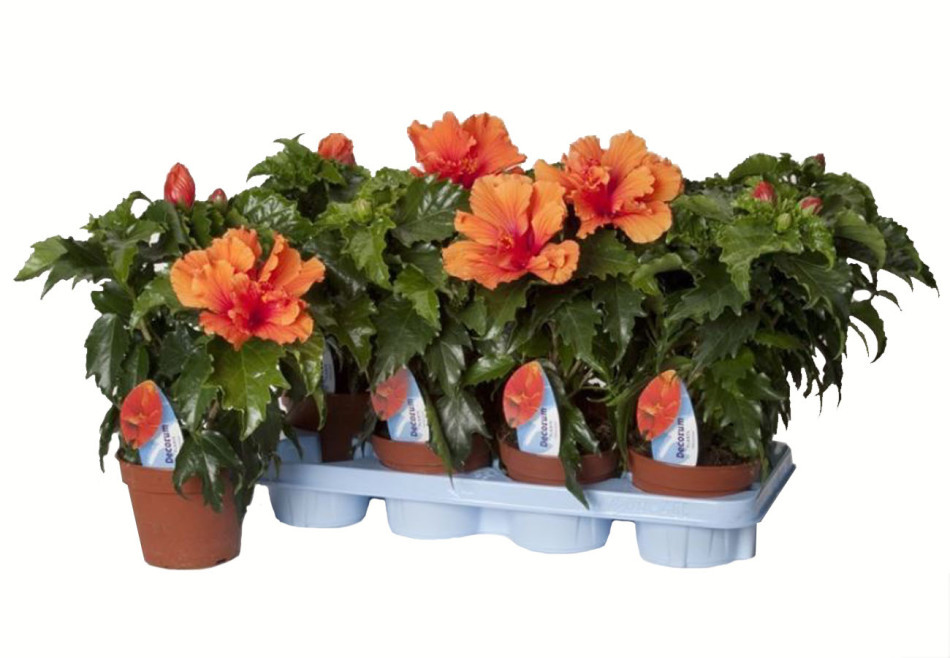 Hibiscus terry
Hibiscus terry Care for double hibiscus does not differ from the general recommendations for the care of hibiscus at home( see the beginning of the article)
The only thing that should be considered in more detail - the reproduction of the plant in the homeconditions
Terry hibiscus propagates by stem cuttings, while preserving all the characteristics of the mother plant
. The flower, which will become the mother plant, must be absolutely healthy and have aplant from 1 year. The age of the shoot should also exceed 1 year
How to prepare the cutting?
- Use a sharp tool to cut off the shoot. The tool must be treated with alcohol or any other disinfectant solution
before use. Note: shoots must be absent
- foreign spots
- rotten areas
- signs of infection with pests
- signs of infection with virus infections
- Cut obliquely into several parts, each 8 cm long. Cut off parts should have several leaves and several nodes( growth points)
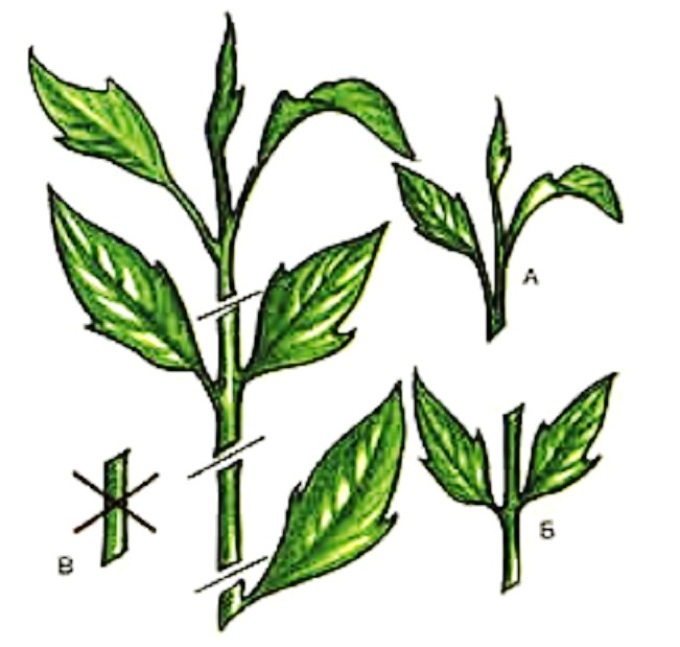 A - apical stem;B - correctly cut cut with knot;B - incorrectly cut cutting with the node
A - apical stem;B - correctly cut cut with knot;B - incorrectly cut cutting with the node - Slice on the mother plant, sprinkle with activated charcoal, crushed into powder. Activated charcoal is processed and the upper cut of the cuttings( if any)
- Cut the lower leaves from the cuttings( if any) and place the cuttings in a solution of heteroauxin( heteroauxin fertilizers to activate the root formation).Before applying fertilizers, be sure to read the instructions of
. Important: Hibiscuses do not take root in the aquatic environment. To fully develop the cuttings, a special substrate
- is required. The substratum for cuttings consists of equal parts of calcined sand and parboiled peat. Heat treatment of the substrate allows to neutralize the entire pathogenic microflora
- Fill the substrate with transparent disposable cups. Do not forget to pre-pierce the drainage holes in the bottom and bottom of the
- glasses. Place the stalk in the substrate strictly vertically. The second lower growth node should be at the substrate level. Be sure to compact the substrate around the cuttings
- One of the most important conditions for a successful rooting is sufficient moisture. But this does not mean that the substrate needs to be filled with water. The container with the handle should be placed in a plastic bag, creating a semblance of a mini-greenhouse. Do not forget to spray the cuttings daily with clean soft water
- To prevent the development of a fungal disease, once a week, treat the mortar with a solution of an aqueous solution of fundazole( concentration of the substance in water 0.2%).
- Avoid direct sun rays falling on the cuttings. Light should be scattered, but in sufficient quantity. The light period for cuttings should be 12 hours, then a night break follows. To extend the light day it is possible with the help of phytolamps
- Try to create optimal temperature conditions. The optimum temperature indicator for fast and high-quality root formation is usually considered to be + 25 ° C
. If you did everything correctly, you will see the results of rooting in 30 days.
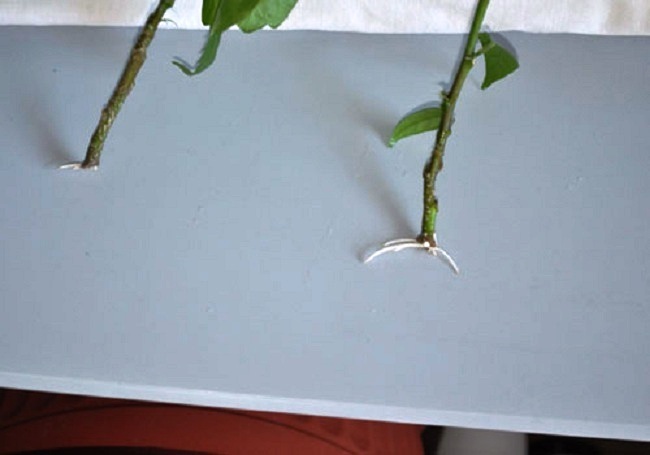 Drawn with drilled roots
Drawn with drilled roots Now cuttings should be gradually acclimated and transplanted into suitable vases
Cultivation and care for Syrian hibiscus. Growing and caring for treelike hibiscus
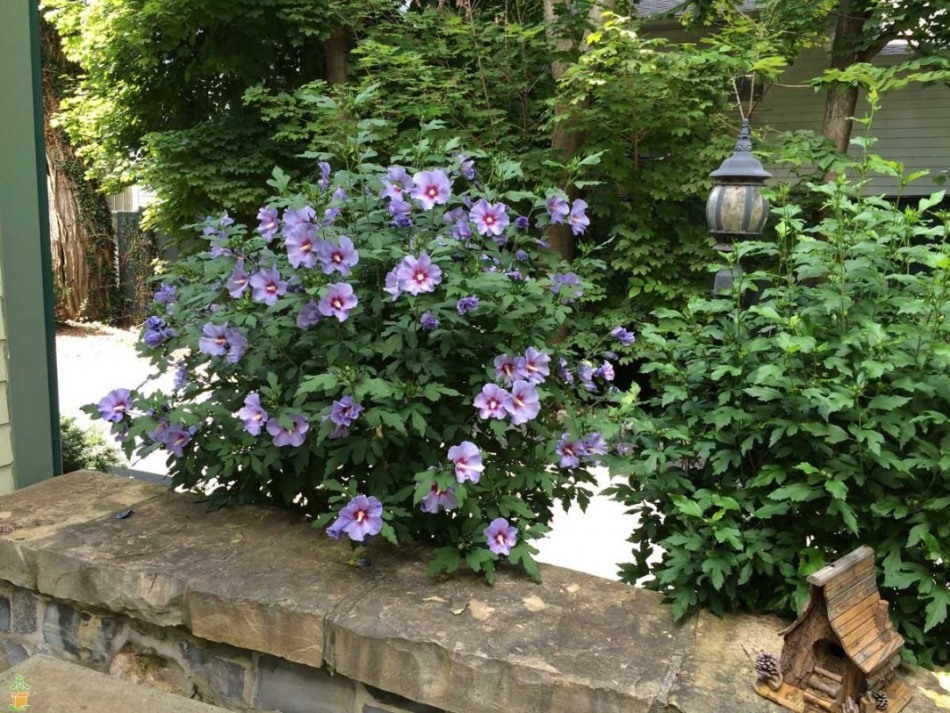 Syrian hibiscus( tree-like hibiscus) is one of the most popular garden plants
Syrian hibiscus( tree-like hibiscus) is one of the most popular garden plants Distinctive features:
- life form - shrub
- cold-resistant
- grows very slowly
- begins to bloom in adulthood( 3-4 years)
- flowering periodbush - June-October
- flowering period 1 flower - 24 hours
- lifespan( with proper care) - up to 20 years
General care recommendations:
- Soil
- rich in humus
- moderately loose
- Lighting and temperature regime
Sunny section, protected from drafts
- Watering
During flowering period - regular
- Feeding
During flowering and growth - regular
Before the onset of the sleep period, it needs potassium supplementation- Needs regular pruning!
Features of care for young bushes: require additional winter shelter
Growing and care of herbaceous hibiscus
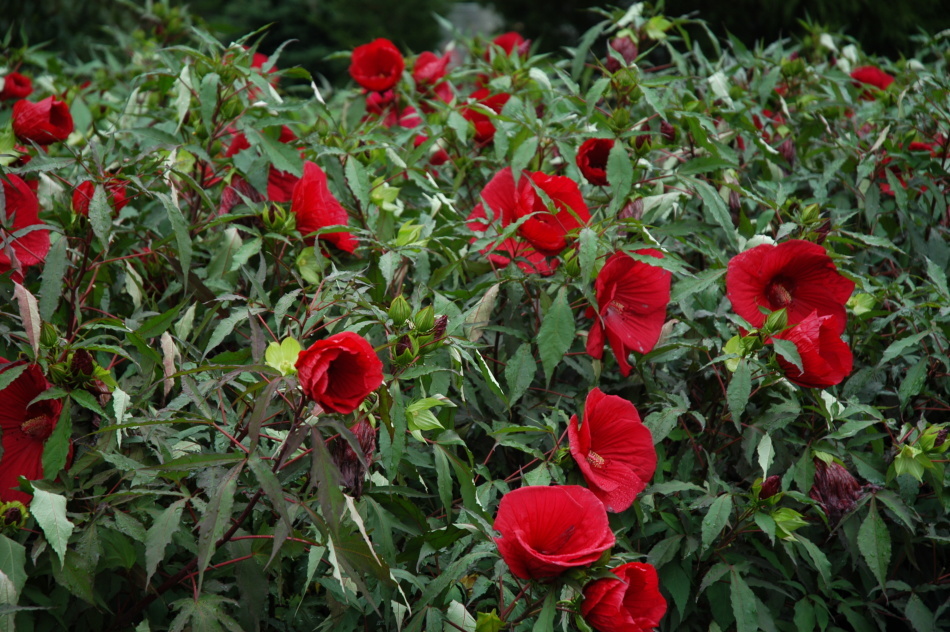 Herbaceous hibiscus
Herbaceous hibiscus Features:
- vital form - perennial herb
- cold-resistant
- in winter surface part dies
- can reach heights up to 3 m
- periodflowering - June-October
- the size of the peduncle is 2-3 times the size of the flowers of the tree-shaped hibiscus
General recommendations for care:
- Soil
- rich in humsom
- moderately loose
- desirable - loam
- Lighting and temperature mode
Solar section, protected from drafts. In the spring period of awakening requires the construction of a temporary greenhouse
- Watering
During flowering - regular. Needs also spraying( especially in a dry microclimate)
- Fertilizing
During flowering and growth - regular
- Needs spring hygienic cleaning of a weak young shoot and in easy pruning of strong shoots
- Transplantation to a new place is necessary every 4 years. In the process of transplantation, special attention is required to the roots of the plant. Damage to one of the tubers can lead to the death of hibiscus
- Propagated by cuttings, seeds, chunks
Propagation of hibiscus at home
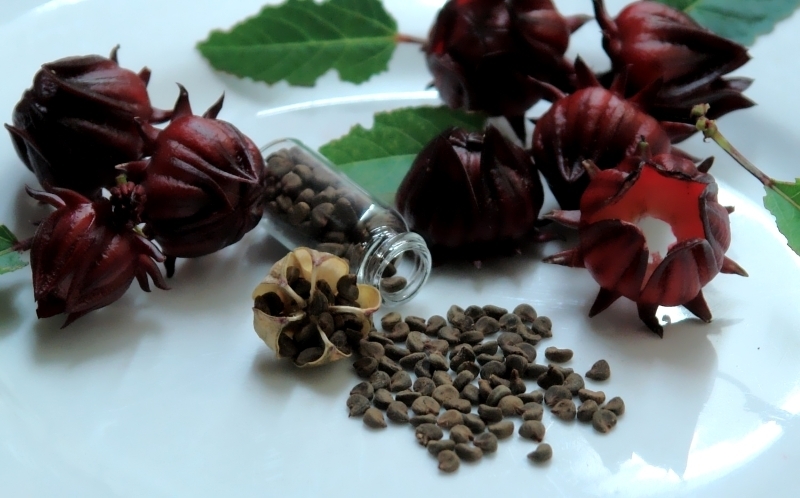 Hibiscus seeds
Hibiscus seeds We have already spoken about the rules of hibiscus propagation by
This section is devoted to propagation of hibiscus seeds. Before you start growing hibiscus from seeds, take into account the following
- not all the seeds come up
- not all seeds that have risen will give full seedlings
- not all seedlings will survive
- not all planted in open soil, young seedlings will become mature plants
- an adult plant will blossom only after 3-4 years
Experienced growers consider the following statistics to be successful: 4-5 adult plants out of 10 seeds
Huge plus of hibiscus cultivation from seeds harvested by hand - completely unexpectedAnno you can get a completely unique plant!
- Period January-February. Stratify the seed. Plant seeds in a convenient container, for example in a plastic container. Fill with a thin layer of substrate( sand and peat in equal proportions).The substrate is slightly moistened with an atomizer. Cover the container and place in the refrigerator for 30 days
- February-March. Remove the container with seed from the refrigerator. Once again, moisturize with an atomizer. Cover it with a lid. Place in a warm place. Check the humidity inside the container daily. After 3-5 days most of the seeds will have white rootlets
- . Transfer the seed to plastic disposable cups. Do not forget to make drainage holes in the bottom of each of the glasses. The spine should be on the bottom when landing! The depth of planting is 2-3 mm. Soil recommendations are provided at the beginning of the article
- Set the cups in a tray with small pebbles or expanded clay
- Provide good seeding for
- seedlings without direct sunlight
- Absence of drafts
- High humidity
- Temperature regime within 25 ⁰С
- Second half of May is the time to plant seedlings inopen ground. On the eve of this, gentle seedlings should be gradually hardened, bringing fresh air to
- . The best conditions for planting seedlings are rainy weather.
Recommendations on site selection and preparation are presented in the previous sections of the article.
. Hibiscus transplantation
Indoor plants are transplanted by transshipment into a larger
potTransplanting garden plants requires special care to avoid damage to the roots of the plant
Video: Spring transplant and trimming of hibiscus
Why not colort room flower hibiscus: what to do?
Important: Buds are laid only on young branches!
For the abundant flowering, hibiscus simply needs pruning
The lack of colors can also indicate the wrong watering regime or insufficient nutrients in the
soil. Why the leaves and buds of the hibiscus fall yellow and fall:
flower diseases Symptom: the lower leaves fall
Cause: chlorosis
Treatment: chlorosis occurs against the background of an overabundance of calcium chloride in the water, which you water the plant. Change the waterSymptoms: drooping and flaccid leaves with permanently moist soil
Cause: excess nitrogen fertilizer
Treatment: optimize plant feeding regimeInfestation of aphids, thrips, whitefly, spider mite
Treatment: systemic treatment with insecticidesSymptoms: yellow leaves
Reason: overabundance /lack of sunlight
Treatment: light day for hibiscus should be 6-12 hours. In this case, the sunlight must be scattered. If the light is not enough, use artificial lighting( special phyto-lamps)Video: Hibiscuses on the windowsill
